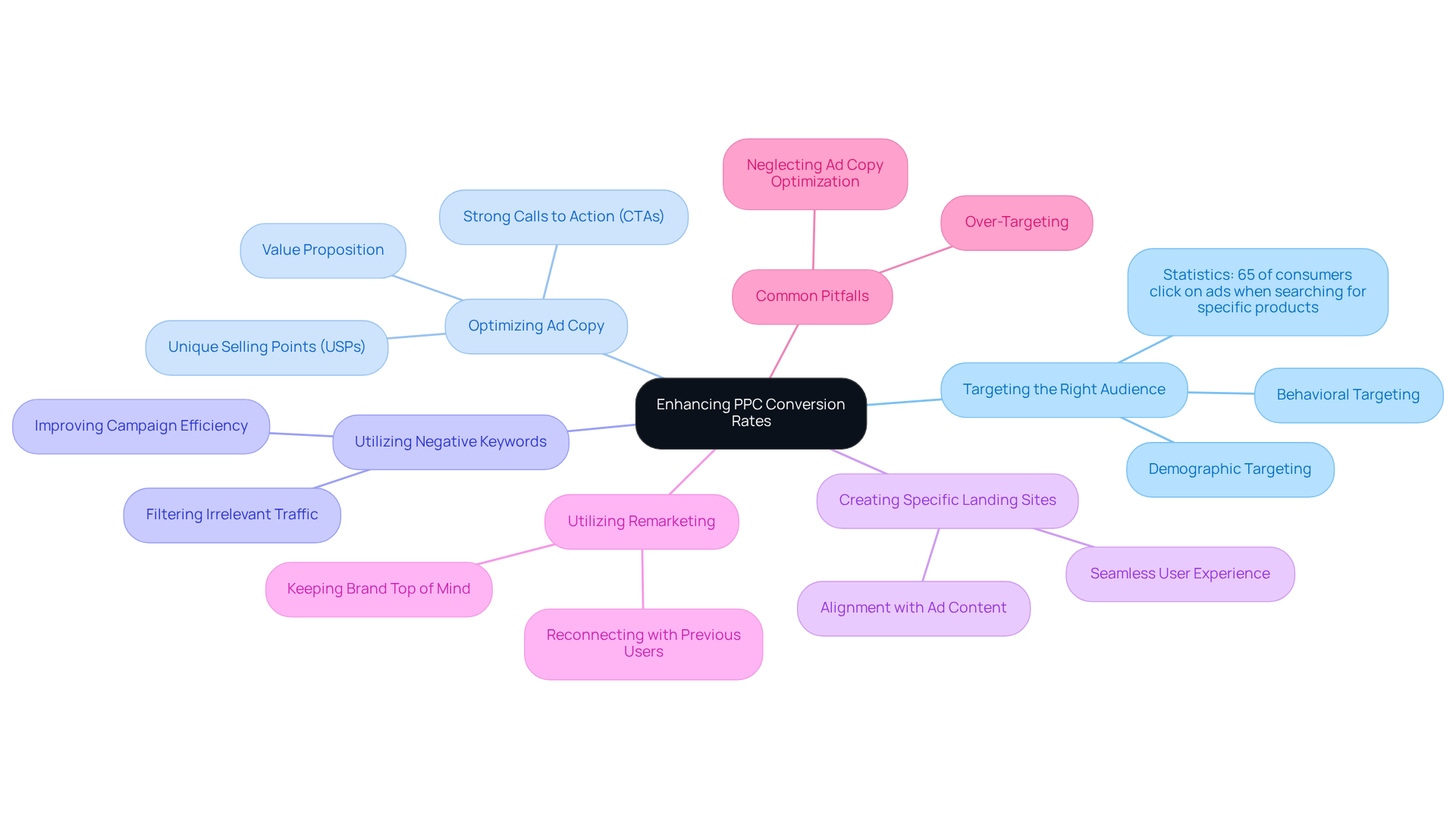
Overview
Boosting the PPC conversion rate is crucial for direct-to-consumer (DTC) brands aiming to maximize their advertising effectiveness. By targeting the right audience, optimizing ad copy, and employing negative keywords, brands can significantly enhance their ad performance.
Creating aligned landing pages is another vital strategy. When users click on an ad, they expect a seamless experience that matches their search intent. A well-optimized landing page not only improves user engagement but also drives higher conversion rates.
Implementing A/B testing is essential for refining these strategies. By experimenting with different ad copies and landing page designs, brands can identify what resonates best with their audience. This data-driven approach not only boosts engagement but also leads to increased revenue growth without the need for higher advertising spend.
In conclusion, DTC brands must adopt these effective strategies to enhance their PPC conversion rates:
- Focus on the right audience
- Optimize every aspect of their campaigns
- Continuously test and refine their approach
By following these steps, they can achieve significant results in a competitive marketplace.
Introduction
Understanding the complexities of pay-per-click (PPC) advertising is vital for direct-to-consumer (DTC) brands that want to maximize their marketing effectiveness. The PPC conversion rate is a key metric, indicating how well ads resonate with the target audience and drive desired actions. By exploring proven strategies to enhance this rate, brands can tap into significant revenue potential while optimizing their advertising spend.
However, as the competitive landscape continues to evolve, what are the most effective tactics DTC companies can employ to ensure their PPC campaigns not only attract clicks but also convert them into loyal customers? It's time to delve into actionable insights that can transform your approach to PPC advertising.
Define PPC Conversion Rate and Its Importance
The proportion of users who take a desired action after clicking on a pay-per-click ad is indicated by the PPC conversion rate. This action can vary widely, from making a purchase to signing up for a newsletter. For direct-to-consumer (DTC) companies, a higher success measure indicates that their advertisements effectively attract the right audience and encourage meaningful interactions with the business.
Understanding this metric is essential, as it directly correlates with the PPC conversion rate and the return on investment (ROI) from advertising spend. For instance, if a company achieves a PPC conversion rate of 5%, it signifies that 5 out of every 100 clicks result in a sale. This statistic underscores the efficiency of their advertising strategy.
Enhancing this metric can lead to significant revenue growth without the need for additional advertising expenses. Therefore, it becomes a primary focus for companies striving to increase profitability. By prioritizing PPC success ratios, businesses can optimize their marketing efforts and drive better results.

Implement Effective Strategies to Enhance PPC Conversion Rates
To enhance PPC conversion rates, DTC brands must adopt effective strategies that drive results:
-
Targeting the Right Audience: It’s crucial to leverage demographic and behavioral targeting to ensure ads reach users most likely to convert. Platforms like Google Ads and Facebook Ads offer robust targeting options, allowing brands to refine their audience effectively. In fact, statistics show that 65% of consumers click on ads when searching for specific products, highlighting the importance of precise targeting. Focused PPC campaigns can significantly enhance success metrics.
-
Optimizing Ad Copy: Crafting compelling ad copy is essential. Clearly communicate the value proposition, highlight unique selling points (USPs), and include strong calls to action (CTAs) that encourage users to click. Engaging advertisement text can profoundly impact user interaction and overall success metrics.
-
Utilizing Negative Keywords: Implementing negative keywords is a smart strategy to filter out irrelevant traffic. This approach focuses ad spend on users more likely to convert, thereby improving the PPC conversion rate. By excluding terms that don’t align with the brand's offerings, marketers can enhance campaign efficiency.
-
Creating Specific Landing Sites: Design landing pages tailored to the ad content. Ensure that the messaging, visuals, and CTAs on the landing page align with what was promised in the ad, creating a seamless user experience. This alignment is vital; Parah Group's comprehensive strategy to CRO emphasizes the significance of unified messaging, which can greatly enhance success in attracting customers.
-
Utilizing Remarketing: Apply remarketing tactics to reconnect with users who have previously engaged with the company but did not convert. Remarketing can significantly boost PPC conversion rates by reminding potential customers of their interest, effectively keeping the brand top of mind. Parah Group's proven strategies in case studies illustrate how effective remarketing can enhance profitability and drive revenue growth.
Common Pitfalls: While executing these strategies, companies must be wary of common pitfalls such as over-targeting, which can limit reach, and neglecting ad copy optimization, which can lead to lower engagement. By steering clear of these missteps, DTC companies can further enhance their PPC campaign effectiveness.
By applying these strategies and being mindful of potential challenges, DTC brands can optimize their PPC campaigns, leading to improved success and overall performance.

Align Ad Copy with Landing Pages for Better Results
Aligning ad copy with landing sites is crucial for maximizing the PPC conversion rate. To achieve this alignment, consider the following key practices:
-
Message Consistency: The messaging in your ad must correspond directly with the content on the landing site. For instance, if an advertisement promises a discount, the landing area should prominently display that discount. This alignment fulfills user expectations and builds trust.
-
Visual and Functional Continuity: Consistency in design between the advertisement and the destination is vital. Utilize similar colors, fonts, and imagery to create a cohesive experience that reinforces your brand identity. This visual harmony not only enhances user experience but also strengthens brand recognition.
-
Clear CTAs: The call to action (CTA) on the landing site should mirror the CTA in the ad. If your advertisement encourages users to 'Shop Now,' ensure that the destination features a noticeable 'Shop Now' button that is easy to locate and click. This clarity drives user engagement and conversion.
-
Fast Loading Speeds: Quick loading times are essential. A delay can lead to high bounce rates, as users are likely to abandon a site that takes too long to load. Utilize tools like Google PageSpeed Insights to identify areas for improvement and ensure a seamless user experience.
-
Mobile Optimization: With a significant portion of traffic coming from mobile devices, it’s imperative that both ads and landing sites are optimized for mobile viewing. This includes implementing responsive design and ensuring easy navigation, catering to the needs of mobile users.
By adhering to these practices, you can significantly enhance the effectiveness of your PPC campaigns, driving a higher PPC conversion rate and achieving your marketing goals.

Utilize A/B Testing and Data Analysis for Ongoing Improvement
A/B testing and data analysis are crucial for optimizing PPC strategies. Here’s how to implement these practices effectively:
-
Identify Key Variables: Focus on specific elements of your ads and landing pages to test, such as headlines, images, calls to action (CTAs), or layout.
-
Create Variations: Develop two versions of the ad or landing page, changing only one variable at a time. This approach provides a clear understanding of which modifications impact success levels.
-
Run Tests Simultaneously: Conduct A/B tests concurrently to control for external factors like time of day or day of the week, ensuring the accuracy of your results.
-
Analyze Results: Use analytics tools to track key performance indicators, including click-through rates, conversion ratios, and bounce rates. This data will reveal which version performs better.
-
Iterate and Optimize: Based on your findings, implement the winning variation and continue testing other elements. This iterative process fosters continuous improvement in your PPC campaigns, adapting to user behavior and preferences.
By leveraging data analysis, DTC companies can significantly enhance their PPC conversion rate. Brands that regularly test and optimize their campaigns often see substantial increases in ROI, with targeted advertising yielding better results. As one data analyst noted, understanding customer behavior through first-party data is essential for crafting effective marketing strategies. Regular A/B testing not only refines ad performance but also aligns campaigns with evolving consumer expectations, ultimately driving growth and profitability.

Conclusion
Boosting the PPC conversion rate is not just beneficial; it’s essential for DTC brands that want to maximize their advertising effectiveness and overall profitability. By understanding and implementing proven strategies—like targeting the right audience, optimizing ad copy, and ensuring alignment between ads and landing pages—businesses can significantly enhance user engagement and conversions. These practices are crucial, as they directly correlate with the return on investment from advertising efforts.
Key strategies include:
- Precise targeting
- Crafting compelling ad content
- Employing negative keywords to filter traffic effectively
- Creating tailored landing pages
- Leveraging remarketing tactics to drive conversions even further
Consistency between ad messaging and landing page content is vital in building trust and meeting user expectations. Moreover, A/B testing and data analysis play a critical role in refining PPC strategies, ensuring continuous improvement and adaptation to consumer behavior.
Ultimately, DTC brands must prioritize the optimization of their PPC campaigns. By embracing these best practices and staying vigilant against common pitfalls, companies can improve their PPC conversion rates while fostering long-term customer relationships and driving sustainable growth. Taking action today to implement these strategies could lead to significant advancements in advertising success and overall business performance.
Frequently Asked Questions
What is PPC conversion rate?
PPC conversion rate is the proportion of users who take a desired action after clicking on a pay-per-click ad, which can include actions like making a purchase or signing up for a newsletter.
Why is the PPC conversion rate important?
The PPC conversion rate is important because it indicates how effectively advertisements attract the right audience and encourage meaningful interactions, directly correlating with return on investment (ROI) from advertising spend.
How is the PPC conversion rate calculated?
The PPC conversion rate is calculated by dividing the number of conversions (desired actions taken) by the total number of clicks on the ad, then multiplying by 100 to get a percentage.
What does a PPC conversion rate of 5% signify?
A PPC conversion rate of 5% signifies that 5 out of every 100 clicks on the ad result in a sale, highlighting the efficiency of the advertising strategy.
How can enhancing the PPC conversion rate impact a business?
Enhancing the PPC conversion rate can lead to significant revenue growth without the need for additional advertising expenses, making it a primary focus for companies aiming to increase profitability.
What should businesses prioritize to improve their PPC results?
Businesses should prioritize PPC success ratios to optimize their marketing efforts and drive better results.
FAQs











